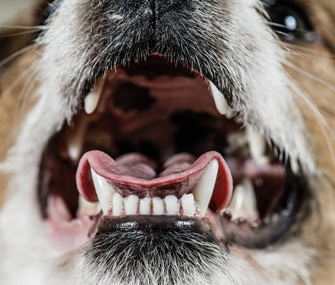5 Pet Dental Health Myths Debunked
Published on February 05, 2016
Skip To

Your pet’s mouth can tell you a lot about his health, but there are a number of myths and misconceptions out there about pet dental care. I talked with my colleague Dr. Laura LeVan, a veterinary dental specialist in Concord, Massachusetts, to find out what information is true and what bites.
True or False?
1. It’s normal for pets to have bad breath.Absolutely not! Your pet shouldn’t have bad breath any more than you should. “Bad breath isn’t always coming from the oral cavity,” Dr. LeVan says. “It can be coming from any part of the upper digestive tract, and it is not normal.” If your pet does have bad breath, take him to the veterinarian for a checkup and schedule a professional cleaning or other recommended treatment to help manage the problem.
2. Pets can clean their teeth themselves by gnawing on dental chews or toys, raw bones and antlers.
Also false. Bones and antlers are hard and can break the teeth of dogs who are vigorous chewers — and they can get caught in the dog’s mouth and cause injuries. And while certain chew toys can provide limited dental health benefits — such as rope bones, which may have a sort of flossing effect, and nubbly chews, which can help to stimulate the gums — chewing alone doesn’t keep teeth and gums healthy.
3. Dry food helps to keep a pet’s teeth clean.
True — but with some reservations. There’s a long-standing belief that dry food is better than canned food for dental health because it helps to scrape off tartar. “There is some truth to that,” Dr. LeVan says. “There is a variety of opinion, but anything that’s a little bit abrasive does help to keep plaque and calculus off teeth.” That doesn’t mean, though, that your pet should get only dry food. Lots of factors play into the choices we make for pet foods, and each type of food has pros and cons. Pets are individuals, and what works well for one may not be the best choice for another. Talk with your veterinarian about your pet’s diet — and his dental health.
4. A dog’s mouth is cleaner than a human mouth.
Legends about the healing powers of a dog’s lick notwithstanding, this myth is just not true. “The fact of the matter is, dogs and humans all have bacteria in their mouths,” Dr. LeVan says. “Dogs have a different population of bacteria, but that doesn’t make their mouths cleaner.” Some dogs love to lick their people, but avoid letting your dog lick open sores or cuts on your body — and if a dog bites you, clean the wound thoroughly with soap and water.
5. Nothing can be done to prevent pet dental disease.
The good news is that this myth is untrue as well. The most cost-effective thing you as a pet owner can do to help prevent or slow the progression of periodontal disease is to brush your pet’s teeth daily to help remove plaque and prevent tartar buildup. “It is the gold standard for preventive care,” Dr. LeVan says.
More on Vetstreet:

